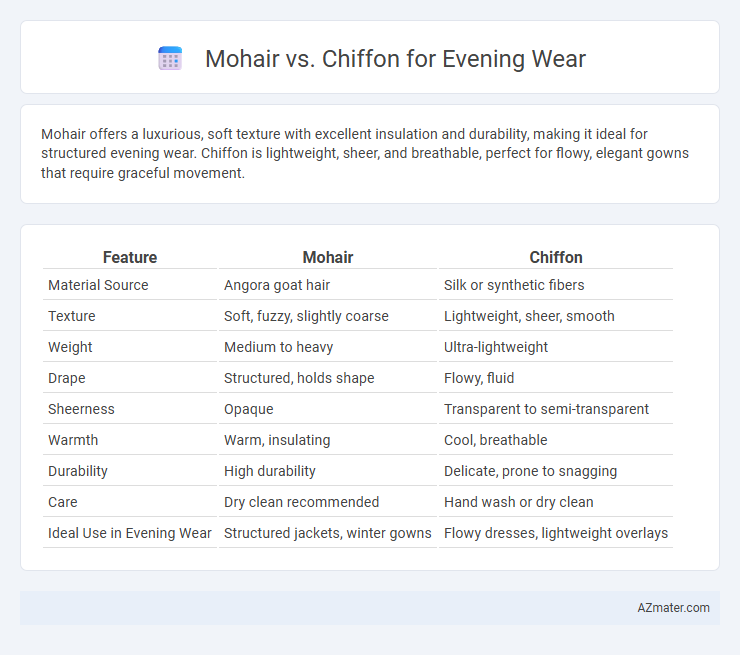Mohair offers a luxurious, soft texture with excellent insulation and durability, making it ideal for structured evening wear. Chiffon is lightweight, sheer, and breathable, perfect for flowy, elegant gowns that require graceful movement.
Table of Comparison
| Feature | Mohair | Chiffon |
|---|---|---|
| Material Source | Angora goat hair | Silk or synthetic fibers |
| Texture | Soft, fuzzy, slightly coarse | Lightweight, sheer, smooth |
| Weight | Medium to heavy | Ultra-lightweight |
| Drape | Structured, holds shape | Flowy, fluid |
| Sheerness | Opaque | Transparent to semi-transparent |
| Warmth | Warm, insulating | Cool, breathable |
| Durability | High durability | Delicate, prone to snagging |
| Care | Dry clean recommended | Hand wash or dry clean |
| Ideal Use in Evening Wear | Structured jackets, winter gowns | Flowy dresses, lightweight overlays |
Introduction to Mohair and Chiffon
Mohair, derived from the Angora goat's silky fibers, is prized for its luxurious sheen, durability, and insulating properties, making it a unique choice in evening wear textiles. Chiffon, a lightweight, sheer fabric typically made from silk or synthetic fibers, offers an ethereal drape and delicate texture favored for elegant gowns and overlays. Both fabrics excel in creating sophisticated silhouettes, yet mohair provides warmth and structure while chiffon emphasizes fluidity and lightness.
Fabric Origins and Composition
Mohair originates from the Angora goat, offering a lustrous, silky texture composed primarily of long, fine fibers of keratin protein. Chiffon, derived from silk, nylon, polyester, or rayon fibers, features a lightweight, sheer weave with a slightly rough texture. The distinct fiber compositions influence mohair's warmth and sheen versus chiffon's airy drape, guiding their selection for elegant evening wear.
Texture and Appearance Comparison
Mohair fabric exhibits a lustrous, silky texture with a natural sheen, creating an elegant and luxurious appearance ideal for structured evening wear. In contrast, chiffon is lightweight, sheer, and airy, offering a soft, flowing drape that enhances movement and adds a delicate, ethereal quality to gowns. The textured richness of mohair contrasts with chiffon's translucent smoothness, making each suitable for different stylistic effects in formal attire.
Comfort and Breathability in Evening Wear
Mohair offers a luxurious feel with natural breathability, making it ideal for evening wear that requires warmth without overheating. Chiffon is lightweight and airy, providing excellent comfort through its sheer, breathable fabric that drapes elegantly. Choosing between mohair and chiffon depends on the desired balance of warmth and ventilation for sophisticated, comfortable evening attire.
Durability and Longevity
Mohair fabric, derived from the Angora goat's hair, offers superior durability and resistance to wear compared to chiffon, making it ideal for long-lasting evening wear. Chiffon, a lightweight and sheer fabric typically made from silk or synthetic fibers, is more delicate and prone to snagging and tearing under frequent use. Evening gowns crafted from mohair maintain their shape and texture over time, while chiffon garments require careful handling to preserve their longevity.
Draping and Silhouette Effects
Mohair offers a luxurious texture with a subtle sheen, creating structured yet soft draping that enhances tailored evening wear silhouettes. Chiffon, known for its lightweight and sheer quality, produces fluid, airy drapes that flow effortlessly, ideal for ethereal, romantic gowns with billowing skirts. The choice between mohair and chiffon significantly impacts the silhouette, with mohair emphasizing defined shapes and chiffon highlighting movement and softness.
Color Range and Dyeability
Mohair offers a rich color range due to its natural fibers that absorb dyes deeply, resulting in vibrant and long-lasting hues ideal for elegant evening wear. Chiffon, typically made from silk or synthetic fibers, provides a softer pastel palette and can be dyed in a variety of shades, though its delicate texture demands gentle dyeing processes to maintain fabric integrity. Both fabrics allow for versatile evening wear options, with mohair excelling in saturated colors and chiffon favored for its ethereal, sheer color effects.
Seasonality: Best Occasions for Each Fabric
Mohair, known for its warmth and luxurious texture, is ideal for evening wear during cooler seasons like fall and winter, providing both elegance and insulation. Chiffon, lightweight and breathable, excels in spring and summer events, offering a flowy, delicate drape perfect for warm-weather occasions. Each fabric's seasonality defines its suitability, with mohair best suited for formal cold-weather gatherings and chiffon favored for airy, sophisticated warm-weather soirees.
Care and Maintenance Requirements
Mohair evening wear requires delicate care, including gentle hand washing or dry cleaning to maintain its softness and prevent damage to its natural fibers. Chiffon, being lightweight and sheer, demands careful handling with hand washing in cold water and avoiding high heat during drying to prevent shrinkage and fabric distortion. Both fabrics benefit from proper storage in breathable garment bags to protect against moisture and wrinkles, ensuring longevity and preserving their elegant appearance.
Mohair vs Chiffon: Which is Best for Evening Wear?
Mohair offers a luxurious, silky texture with natural luster and breathability, making it ideal for elegant evening wear that requires a soft drape and warmth. Chiffon provides a lightweight, sheer, and flowy fabric that excels in creating ethereal, layered silhouettes perfect for formal occasions but lacks insulation. For evening wear, mohair is best suited for structured, warm garments, while chiffon suits designs needing delicate transparency and fluid movement.

Infographic: Mohair vs Chiffon for Evening Wear
 azmater.com
azmater.com